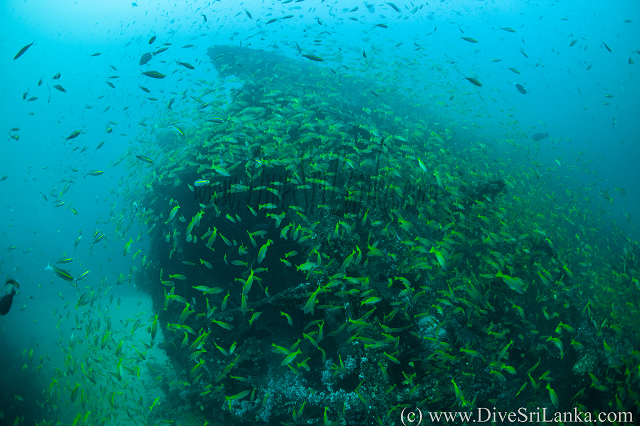
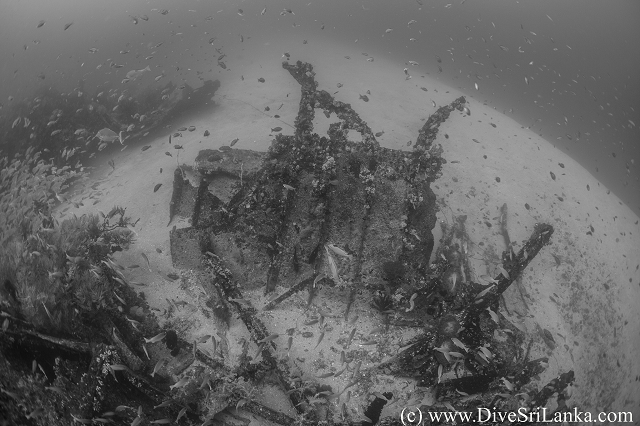
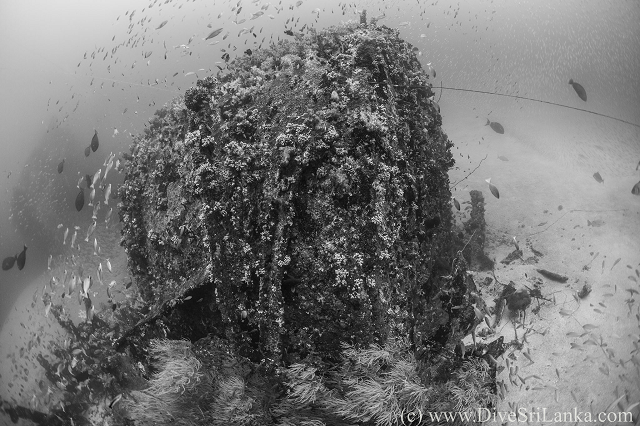
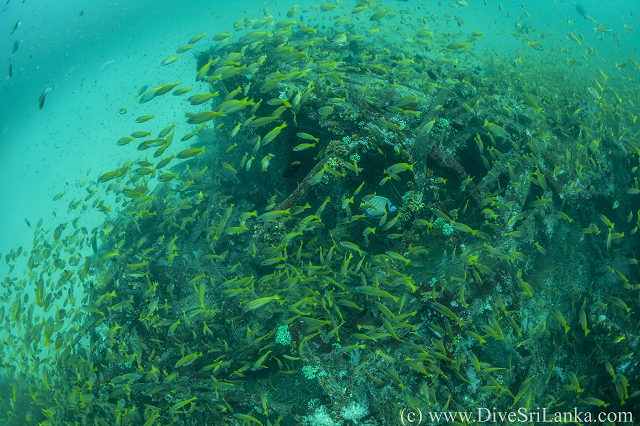

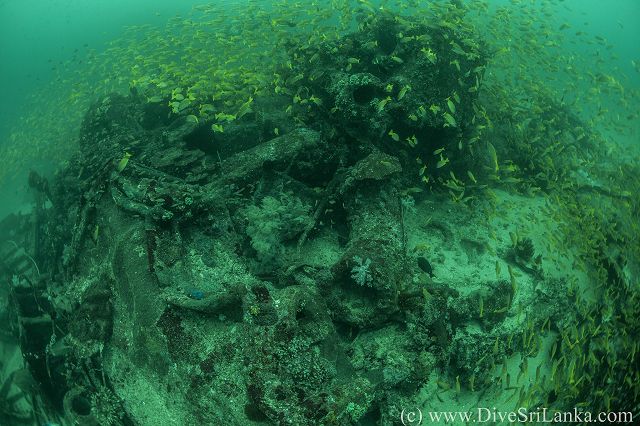
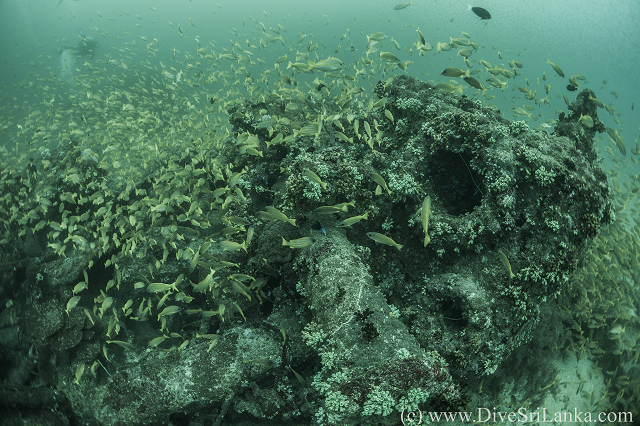

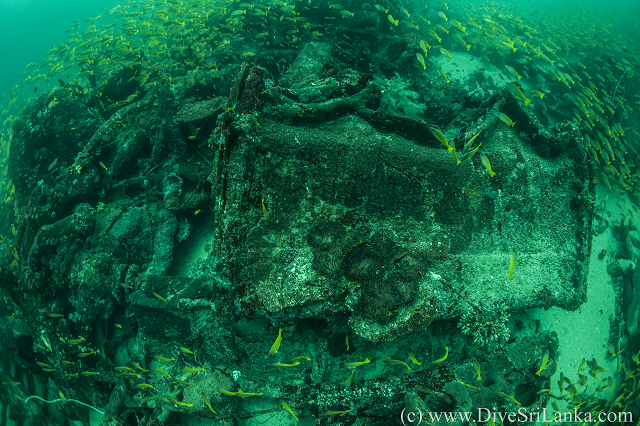
HMS Hollyhock wreck images by kind permission of divesrilanka.com and Dharshana Jayawardena
I have obtained two reports on the sinking of HMS Hollyhock:
The first is a detailed account of the devastating attack on Athelstane, written by the captain of the Athelstane, from the PRO ADM199/2140 pages 177-178.
The second is the official report of Hollyhock’s sinking by Subt. Lt G.B Humby R.N.V.R from PRO ADM199/623.
Captain Moore:
We were bound from Trincomalee to Colombo with a cargo of 7,000 tons of admiralty fuel oil. The ship was armed with a 4 inch gun, 2 rifles & 2 P.A.C rockets. The crew, including 1 Australian Naval Gunner, numbered 52 of whom 3 men were injured. All confidential books, including wireless were thrown overboard in a weighted bag. The vessel was degaussed and the apparatus was switched on.
We left Trincomalee on the 9th April at 0100, sailing independently escorted by HMS Hollyhock, bound for Colombo. At 0900 we saw HMS Hermes, HMS Vampire and the S.S British Sergeant some distance away from us, all three ships being attacked by aircraft and eventually sunk. Shortly afterwards at 1100 about 29 planes flew over at considerable height, apparently monoplane aero-fighters, returning from this attack. As they did not attack us and soon disappeared, I called up Hollyhock to ascertain their identity, and she replied they were presumably Japanese, as they had ignored their signals.
HMS Hermes
We proceeded at 9 knots steering a southerly course, weather was fine with good visibility, smooth sea with light airs. The sun was directly overhead when at 1207 A.T.S, on the 9th April, in position 7° 31'N, 82° E, we sighted a large number of planes approaching from the south, that is from directly ahead. They were zero fighters about 29 of them as far as I could count, then I noticed 9 planes in a V formation making straight toward us, flying at a height of about 10,000ft, (in reality they were D3A-1 'VAL' dive bombers, 20 in number).
D3A-1 'VAL' dive-bomber
I ordered the crew to take cover behind the sandbags as we had no A.A armament, and as I did so the planes formed into single line astern and dived one after the other in rotation in a fore and aft line over the ship. Each plane carried one bomb, which was released at a height of 800 feet, the aircraft pulling out of its dive at about 400 feet. We fired the P.A.C rockets but one jammed in its box, and the other fouled the wireless aerial.
A large number of bombs fell around us, we received 5 direct hits and 2 near misses. the first bomb struck the fore deck between Nos 1 and 2 tanks, the second in almost the same position, the third on No 3 tank, the fourth fell into No 3 tank, exploded in the oil, which was thrown up, smothering everything, and blew a hole in the starboard side shell plating.
The fifth bomb, which fell on the after deck, apparently failed to explode properly, as there was no damage to the deck, the only effect being to throw the gunner at the 4" gun up into the air. One near miss fell off the starboard side, doing no damage, but the other fell off the port side abreast of the engine room amidships, smashing the steering gear out of action.
The whole attack lasted about 5 minutes, during which another formation of enemy aircraft was attacking HMS Hollyhock. The first bomb fell close alongside her, the second struck her near the funnel, probably exploding in her magazine, as she immediately blew up, disintegrating, and sank at 1217.
When the planes flew off I gave the order to lower the boats and abandon ship. We carried 4 lifeboats, of which we could only launch Nos 4 and 4 and a raft. No 1 lifeboat could not be launched owing to the hole in the ship's starboard side, and the after starboard boat No 3 was lowered into the water but was so badly damaged that it became water-logged and drifted away floating on its tanks, and was useless.
The whole ship was covered with oil which had been thrown up from No 3 tank, the boat falls were very slippery, but we managed to lower the two lifeboats successfully, with a few men only in them to lessen the weight. We abandoned ship at 1222, all the crew getting away safely. The mate jumped overboard for some unknown reason, and was picked up later along with gunner A. Goodman, who had been caught by the blast of the last bomb and was either blown overboard or had jumped over, in any event he was in the water. I was in charge of No 2 boat, but I was told that a native in No 4 boat, seeing the gunner in the water, jumped into the sea and swam some considerable distance to him, with a rope, and they were both pulled back into the boat. The native's name is Joseph John, a Christian Hindu. Meanwhile, we pulled our lifeboat for about 1/4 mile to the survivors from the Hollyhock and picked up 14 men (2 officers and 12 ratings): the remainder of the corvette’s crew must have been either killed or drowned, as we did not see any other men in the vicinity.
We rowed and sailed the boats for a distance of about 8 miles towards the land, and landed on the east coast of Ceylon a little to the southward of a village called Kalamani.
The Athelstane finally sank at 1430, nearly 2 1/2 hours after being hit. All the crew behaved remarkably well throughout the attack and there was no sign of panic amongst the native portion of the crew.
Subt. Lt. G.B. Humby:
REPORT ON THE SINKING OF H.M.S “HOLLYHOCK”
1. On the morning of the 9th April, H.M.S “HOLLYHOCK” was proceeding from Trincomalee to Colombo acting as A/S Escort to R.F.A “ATHELSTANE”. Course 167 Deg. Speed of convoy 9 knots. Clear sky, light N.Easterly breeze, very slight swell. Zigzag ahead of “ATHELSTANE”, one mile ahead.
2. The following is a record of relevant events from the first warning of enemy aircraft received. To time of sinking. At 1005 signal received that H.M.S “HERMES” had been sighted by enemy aircraft. At this time “HOLLYHOCK” was 7 miles 120 Degs from “HERMES”. Ships company closed up at A.A stations. Course altered to 200 Deg to close shore.
1037. 25 unknown aircraft sighted to eastward flying north.
1050. H.M.S “HERMES” attacked.
1140. Course altered to 175 Deg.
1145. 18 enemy aircraft flew overhead steering 170 Deg.
1200. Position by cross bearings 07 Deg. 21’ N, 81 Deg. 57’E.
1203. 9 aircraft sighted bearing180 Deg. Flying North.
1204. Ship opened fire with 4” L.A and MK VIII 2 Pdr.
1205. R.F.A. “ATHELSTANE” dive bombed by 5 aircraft. One bomb each. Ship was hit several times and disabled. Crew abandoned ship.
1208. Attack commenced on H.M.S. “HOLLYHOCK”. First bomb exploded on starboard side, 25ft. From ship, abreast of galley. Side fuel tanks burst and No. 2 Boiler put out of action due to strained plating.
1209. Second bomb exploded 30-40 yds. From starboard side of ship between bridge and 2 pdr. Started to close “ATHELSTANE” for survivors.
1217. Third bomb exploded on Engine room casing, disabling Pom-pom, engines, W/T, steering gear. Ship started to settle fast by the stern.
1218. Fourth bomb burst amidships, causing large explosion due to boilers or 2 pdr. Magazine, or both, exploding. Whole of after part of ship disintegrated and ship sank within 30-40 seconds.
METHOD OF ATTACK
Took form of dive bombing from approximately 3000 ft. Bombs released at about 300-400 ft. Single engine A/C type unknown. Undercarriage lowered during dive to act as brake. One bomb only carried. Machine guns not used. First two aircraft came in from ahead, 3rd and 4th, from port beam. Bombs were about 250 lbs, armour piercing.
AVOIDING ACTION
In the 1st and 2nd attacks, avoiding action using full speed turning hard a-port, as aircraft started dive, in which cases action was successful. In 3rd attack which was from port beam, maximum available speed was about 11 knots. Ship was turned towards aircraft (i.e. to port) just after dive commenced. No action could be taken in fourth attack as ship was helpless.
GUNFIRE
Fire was maintained from 4” gun up till the very last moment. Owing to slowness of training gears on 4”, which was damaged by 1st bomb, targets could not be held consequently 11 rounds fired were rather wide. Between 2nd and 3rd attacks pom-pom was jammed for two or three minutes, but apart from this it was firing almost continuously as the aircraft came into attack, until it was put out of action. According to officers of “ATHELSTANE”, one aircraft was seen to be losing height after attacking, and carried a definite list to starboard.
Ship was not fully equipped with close range A.A weapons, there being only one Hotchkiss 303 fired from the shoulder by the first Lieutenant. Single Oerlikons should have been fitted during last boiler cleaning period in Colombo, but in fact only pedestals were placed on board, and these not mounted in spite of signals made from the ship requesting work may be completed before sailing. The two twinLewis 303 which the Oerlikons were to replace, had already been transferred to H.M.S. “ASTER”, to make way for the new guns.
I should like to invite your attention to the great coolness of the layer of the 4” gun, A.B. G.B FAWCET who remained at his gun long enough to get off one round almost instantaneously with the last explosion.
It was noted that the Coxswain C.P.O PRESTON remained at his post despite splinters flying all around him and the wheel-house collapsing. The conduct of the crew as a whole was excellent and the men were at their post right up to the last moment.
G.B. HUMBY
Sub/Lt R.N.V.R
I recently discovered another interesting report about the AA guns being removed from Hollyhock prior to leaving port. The following quote is taken from the obituary of Captain Eric Hewitt, Captain of Corvette HMS Aster & the last commander ofcadet training ship HMS Conway.
"While in Colombo Captain Eric Hewitt RD, RNR was sent to sea on an operation. The corvette HOLLYHOCK was to remain in port so Hewitt had some of her AA armament transferred to the ASTER. In the middle of one night on the patrol the lookout reported a ship ahead. She was challenged. It was the cruiser CORNWALL in company with her sister ship DORSETSHIRE".
The following has been taken from the Eastern Fleet War Diary:
A report on the loss of these ships was forwarded to the Commander in Chief, Eastern Fleet, in my letter of 22nd April, No. E.I. 3181. The circumstances under which the HOLLYHOCK was at sea without her full H.A. armament have been reported separately. I have also written to Their Lordships ‘ favourable notice the gallant conduct of Surgeon Lieutenant J.A. Smart, MB, BC, RNVR of HMS HERMES

